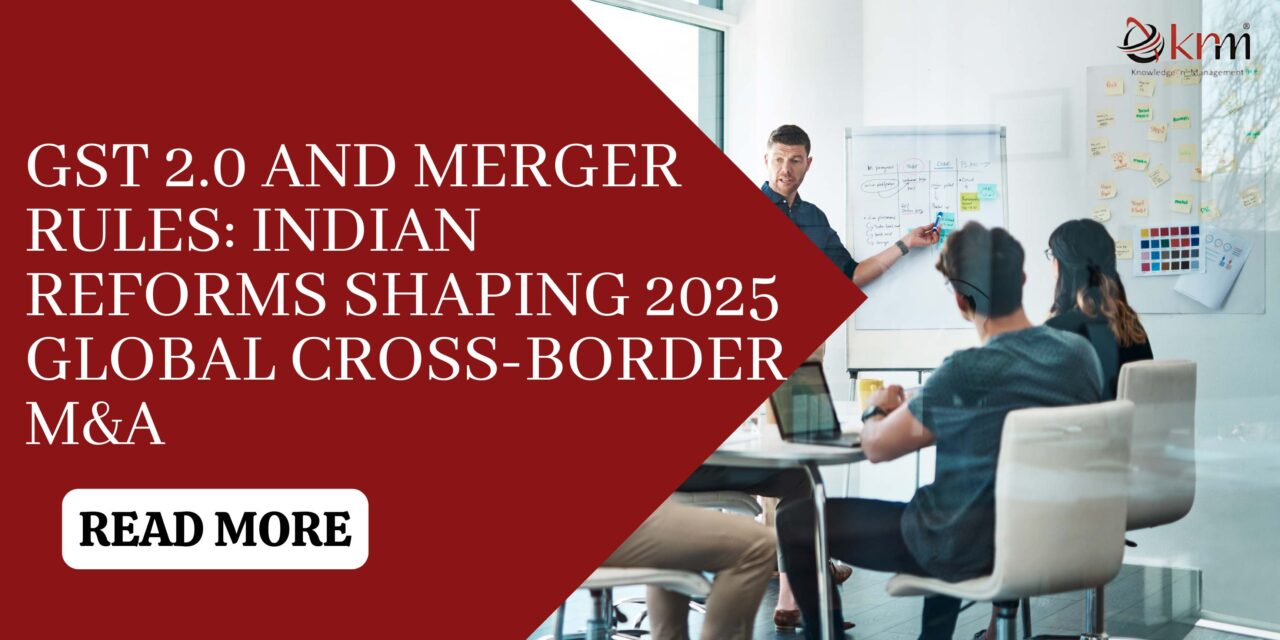India’s business landscape is undergoing a transformative phase in 2025, with two major reforms — GST 2.0 and the updated merger control regulations — redefining how global corporations approach cross-border mergers and acquisitions. These reforms not only streamline indirect taxation but also bring greater transparency, predictability, and compliance clarity for multinational entities looking to expand in India.
This blog explores how these policy shifts impact deal structuring, due diligence, and compliance for foreign investors, and how professional transaction advisory services can help businesses navigate the evolving regulatory environment.
1. The Indian Reform Landscape: GST 2.0 and Merger Control Evolution
The introduction of GST 2.0 marks a significant leap from the earlier framework, emphasizing simplification, digital integration, and cross-border trade alignment. Meanwhile, the Competition (Amendment) Act, 2023, and related merger control updates have tightened scrutiny on global acquisitions to ensure fair competition in India.
| Key Reform Area | Key Change in 2025 | Impact on Cross-Border M&A |
| GST 2.0 Framework | Unified digital compliance and e-invoicing for multinational entities | Simplifies post-merger tax compliance |
| Merger Control Regulations | New thresholds and timelines under the Competition Act | Faster and more predictable M&A clearance |
| Foreign Direct Investment (FDI) Policy | Liberalized caps in key sectors like renewable energy, manufacturing, and fintech | Encourages inbound investments and partnerships |
| SEBI & RBI Oversight | Enhanced reporting norms for cross-border transactions | Improves transparency and investor confidence |
These reforms aim to position India as a global hub for cross-border mergers and acquisitions, offering both regulatory discipline and operational agility.
- How GST 2.0 Impacts Cross-Border M&A Transactions
Under GST 2.0, India has adopted a data-driven compliance framework that directly affects the way multinational companies structure mergers and acquisitions.
a. Seamless Input Tax Credit (ITC) Transfer
One of the major pain points in earlier M&A deals was the delayed transfer of tax credits post-merger. With GST 2.0’s automated matching and validation, ITC transitions can now be processed swiftly, reducing working capital blockage.
b. Consolidated Registration for Multinational Entities
Foreign companies engaging in cross-border mergers and acquisitions can benefit from consolidated GST registration for multi-state operations, reducing redundancy and compliance costs.
c. Data Integration for Compliance
GST 2.0 mandates real-time invoice-level reporting integrated with the government’s data systems, ensuring that M&A due diligence captures accurate tax exposure, vendor compliance status, and liability mapping.
3. Revised Merger Control and FDI Norms: A New Framework for Global Expansion
India’s merger control regime has undergone substantial reform to align with global practices. The Competition Commission of India (CCI) now follows a “deal value threshold” — meaning even smaller acquisitions with significant market implications come under review.
Key Highlights:
- Shorter Approval Timelines: M&A approvals are now processed within 150 days, reducing delays in cross-border transactions.
- Pre-Filing Consultations: Companies can engage with the CCI to identify potential competition concerns early in the deal cycle.
- Sectoral Liberalization: Foreign investment limits have been relaxed in key industries such as defense, renewable energy, and financial services — opening new avenues for strategic cross-border mergers.
For global corporations, this translates into a smoother path for expansion, provided they adhere to India’s evolving compliance framework and legal steps to start a business in India are properly followed.
4. Transaction Advisory Services: The Bridge Between Strategy and Compliance
While reforms have simplified entry, navigating them still demands precision. Professional transaction advisory services play a crucial role in mitigating risks and ensuring alignment with both local and global regulations.
a. Deal Structuring and Tax Strategy
Advisors assess deal structures to optimize tax implications under GST 2.0 and minimize potential double taxation scenarios in cross-border transactions.
b. Legal and Regulatory Due Diligence
A key aspect of successful M&A execution involves reviewing licenses, contracts, and compliance obligations under the legal steps to start a business in India. Advisory firms help ensure that all corporate, tax, and labor law obligations are met pre- and post-transaction.
c. Integration Support
Post-merger integration services — including financial consolidation, vendor re-registration, and accounting harmonization — are essential to achieving operational efficiency.
5. Practical Steps for Multinationals Entering India Through M&A in 2025
For companies planning cross-border mergers and acquisitions in India, here’s a practical roadmap:
| Step | Description | Key Consideration |
| 1. Market Entry Feasibility Study | Evaluate industry viability and regulatory landscape. | Align business goals with FDI rules. |
| 2. Legal Incorporation | Complete the legal steps to start a business in India including incorporation, licensing, and taxation setup. | Seek guidance from professional advisory firms. |
| 3. Due Diligence | Review financials, liabilities, and compliance status of the target company. | Integrate findings into valuation. |
| 4. Merger Structuring | Choose between asset or share acquisition based on GST 2.0 implications. | Optimize for tax efficiency. |
| 5. Post-Merger Compliance | Manage GST, corporate filings, and competition law obligations. | Leverage transaction advisory services for seamless transition. |
6. KNM India: Your Partner for Cross-Border M&A Success
At KNM India, we specialize in guiding multinational businesses through every stage of cross-border mergers and acquisitions. From transaction advisory services and deal structuring to compliance under GST 2.0 and merger regulations, our experts ensure that your entry and expansion in India are both strategic and compliant.
We also assist international clients with the legal steps to start a business in India, regulatory filings, and post-merger integration — ensuring a smooth transition into India’s growing economy.
As India positions itself as one of the fastest-growing M&A destinations globally, KNM India remains a trusted partner for companies seeking sustainable, compliant, and scalable growth.
Conclusion
The convergence of GST 2.0 and India’s redefined merger control regime signifies a new era for global investors. These changes not only simplify cross-border mergers and acquisitions but also create a more transparent, technology-driven, and investor-friendly ecosystem.
With professional guidance from transaction advisory services and a strong understanding of the legal steps to start a business in India, multinational companies can leverage India’s reforms to drive long-term success in 2025 and beyond.


